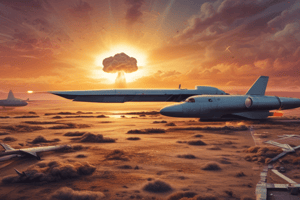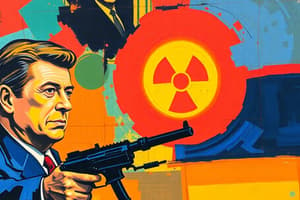Podcast
Questions and Answers
What is a symptom of acute radiation sickness?
What is a symptom of acute radiation sickness?
- Skin rash
- Dizziness (correct)
- Weight loss
- Vision impairment
What method is NOT effective for protecting against radiation exposure?
What method is NOT effective for protecting against radiation exposure?
- Using shielding barriers
- Increasing distance from the source
- Spending more time near the source (correct)
- Minimizing exposure time
Which type of IED relies on human guidance for detonation?
Which type of IED relies on human guidance for detonation?
- Suicide bomb (correct)
- Pressure cooker bomb
- Package IED
- Vehicle IED
Which explosive is frequently associated with large-scale terrorist attacks?
Which explosive is frequently associated with large-scale terrorist attacks?
How does the media outside the US contribute to the atmosphere of fear regarding terrorism?
How does the media outside the US contribute to the atmosphere of fear regarding terrorism?
What is the primary consequence of the nuclear bombings during World War II?
What is the primary consequence of the nuclear bombings during World War II?
Which type of radiation can be effectively stopped by paper or skin?
Which type of radiation can be effectively stopped by paper or skin?
In which application are radioactive materials NOT typically used?
In which application are radioactive materials NOT typically used?
What is a primary characteristic of gamma radiation?
What is a primary characteristic of gamma radiation?
What is the purpose of a radiologic dispersal device?
What is the purpose of a radiologic dispersal device?
Which statement about nuclear waste is correct?
Which statement about nuclear waste is correct?
Which type of radiation has the highest penetrating power?
Which type of radiation has the highest penetrating power?
How does nuclear energy produce radiation?
How does nuclear energy produce radiation?
Study Notes
Historical Incidents of Nuclear Weapons
- Two publicly known incidents of nuclear bombings during World War II.
- Estimated 214,000 deaths resulted from these atomic bombings.
- Some nations linked with terrorist organizations possess nuclear capabilities.
Ionizing Radiation
- Ionizing radiation emitted as rays or particles from radioactive materials.
- Found in unstable rocks and metals that undergo a natural process called decay, releasing radiation over time.
- Decay duration can range from minutes to billions of years.
Types of Radiation
- Alpha Radiation: Least penetrating; can be stopped by paper or skin.
- Beta Radiation: More penetrating than alpha; needs a layer of clothing for protection.
- Gamma Radiation: Stronger and faster than both alpha and beta; requires several inches of lead or concrete for shielding.
- Neutron Radiation: Most powerful and fast-moving; can penetrate lead and needs several feet of concrete to be stopped.
Uses and Waste of Radioactive Materials
- Radioactive materials are beneficial in medicine (e.g., sterilizing), food preservation, and construction.
- Remaining radioactive materials after use are termed radiologic waste and are still hazardous.
- Waste found in hospitals, universities, chemical sites, and power plants.
Radiologic Dispersal Devices
- Also known as dirty bombs; designed to scatter radioactive material.
- Explosive component can cause injury alongside radiation; effectiveness in destruction limited to explosives alone.
- Creates psychological fear despite minimal physical damage.
Nuclear Energy and Waste
- Nuclear energy generated from splitting radioactive atoms releases immense heat energy.
- Applications include medicine, naval vessels, and power generation; produces all radiation forms as byproducts.
- Nuclear waste remains radioactive and poses hazards post-use.
Radiation Exposure and Health Effects
- Types of exposure include radioactive exposure, external contamination, and internal contamination.
- Acute radiation sickness symptoms: dizziness, nausea, vomiting, diarrhea, altered mental status.
- Direct exposure does not equate to contamination; contamination occurs when radioactive materials are on the body.
Radiation Safety and Protection
- Use time, distance, and shielding to protect from radiation exposure.
- Spending less time near a source reduces effects; moving away increases safety.
- Shielding includes using substantial barriers like concrete or buildings.
Terrorism and Explosive Devices
- IEDs (Improvised Explosive Devices) are the most common terrorist weapons.
- Categories include package IEDs, vehicle IEDs, and suicide bombs.
- Explosives like ammonium nitrate are frequently used for large-scale attacks.
Types of IEDs
- Package IEDs: Examples include pipe bombs from the 1996 Olympic bombing and pressure cooker bombs from the Boston Marathon.
- Vehicle IEDs: Packed vehicles with explosives were used in high-profile attacks like the Oklahoma City bombing.
- Suicide Bombs: Combine explosives with human guidance for effective, low-cost attacks; rely on surprise elements.
Media Representation of Terrorism
- Outside the US, media often broadcasts graphic terrorist propaganda, contributing to the atmosphere of fear.
- Availability of recruits and accessibility of low-tech weapons facilitate terrorist operations.
Historical Incidents of Nuclear Weapons
- Two nuclear bombings occurred during World War II, resulting in a death toll of approximately 214,000.
- Certain nations with ties to terrorist organizations have developed nuclear capabilities, raising global security concerns.
Ionizing Radiation
- Ionizing radiation is released as rays or particles from radioactive materials during the natural process of decay.
- Decay can take a wide range of durations, from minutes to billions of years, depending on the material.
Types of Radiation
- Alpha Radiation: Least penetrating; can be halted by paper or skin.
- Beta Radiation: More penetrating than alpha, requiring clothing for adequate protection.
- Gamma Radiation: Strongest and fastest type; necessitates several inches of lead or concrete for effective shielding.
- Neutron Radiation: Highly powerful and fast-moving; can penetrate lead, needing several feet of concrete to stop it.
Uses and Waste of Radioactive Materials
- Radioactive materials are actively used in fields such as medicine for sterilization, food preservation, and construction.
- The radioactive leftovers after usage, known as radiologic waste, remain hazardous and are found in hospitals, universities, chemical sites, and power plants.
Radiologic Dispersal Devices
- Radiologic dispersal devices, commonly referred to as dirty bombs, are intended to spread radioactive material.
- While they incorporate explosive components that can cause injury, their primary effectiveness relies on the psychological fear they provoke rather than actual destruction.
Nuclear Energy and Waste
- The energy from nuclear reactions stems from splitting radioactive atoms, which produces significant heat energy.
- Applications of nuclear energy include its use in medicine, naval vessels, and power generation, with all forms of radiation produced as byproducts.
- Nuclear waste retains its radioactivity and poses safety hazards long after its generation.
Radiation Exposure and Health Effects
- Exposure types include radioactive exposure, external contamination, and internal contamination, each with distinct implications for health.
- Acute radiation sickness can manifest through symptoms such as dizziness, nausea, vomiting, diarrhea, and altered mental status.
- Direct exposure does not imply contamination; contamination specifically refers to radioactive materials deposited on the body.
Radiation Safety and Protection
- Protection strategies against radiation include time management, maintaining distance, and utilizing shielding.
- Reducing time spent near a radiation source mitigates harmful effects; increasing distance further enhances safety.
- Effective shielding requires constructing substantial barriers, such as concrete structures or buildings.
Terrorism and Explosive Devices
- Improvised Explosive Devices (IEDs) are the primary weapons utilized by terrorists, with various categories for deployment.
- Common categories of IEDs include package IEDs, vehicle IEDs, and suicide bombs, each with distinct operational methods.
- Explosives like ammonium nitrate are frequently chosen for their effectiveness in large-scale attacks.
Types of IEDs
- Package IEDs: Notable examples include pipe bombs used in the 1996 Olympic bombing and pressure cooker bombs from the Boston Marathon attack.
- Vehicle IEDs: Utilizing packed vehicles with explosives, significant attacks have included the Oklahoma City bombing.
- Suicide Bombs: These attacks integrate explosives with human direction, facilitating effective and cost-efficient operations that rely on surprise.
Media Representation of Terrorism
- Many international media outlets disseminate graphic terrorist propaganda, contributing to societal fear.
- The accessibility of low-tech weapons and the availability of potential recruits enhance the operational capabilities of terrorist groups.
Studying That Suits You
Use AI to generate personalized quizzes and flashcards to suit your learning preferences.
Description
Explore the historical incidents of nuclear bombings during World War II and their devastating impacts. Learn about ionizing radiation, its types, and associated protection measures. This quiz delves into the specifics of alpha, beta, gamma, and neutron radiation, highlighting their characteristics and uses.




